
Your Octiv
™
+ hearing instrument
Points out a situation that could
lead to serious, moderate, or
minor injuries.
Indicates possible property
damage.
Advice and tips on how to handle
your device better.
Indicates the legal manufacturer of
the device.
Optional symbol for custom
models with wireless functionality.
012
CE compliance label, confi rms
compliance with certain European
Directives, refer to section
“Conformance information”.
Do not dispose of the device
with general domestic
waste. Read more in section
“Disposal information”.
Read and follow the instructions in
the user guide.
Explanation of symbols
Changing the batteries
Open the battery
compartment
Remove coloured sticker
from new battery, place battery
in drawer with + symbol on
battery + side up. (You should
only remove the protective sticker
if you actually use the battery)
Close battery door
Carefully close the
battery compartment.
If you feel resistance, the
battery is not inserted correctly.
Do not attempt to close the
battery compartment by force.
It can be damaged.
Batteries
Getting to know your
hearing instruments
It is recommended to familiarise
yourself with your new hearing
instruments. With the instruments
in your hand try using the controls
and note their location on the
instrument. This will make it
easier for you to feel and press
the controls while wearing the
hearing instruments.
Components and names
Ear piece
Receiver
Receiver cable
Microphone openings
ૠ Rocker switch
ૡ Battery compartment
ૢ Side indicator
(red = right ear,
blue = left ear)
ૣ Receiver connection
CAUTION
Read this user guide thoroughly
and completely and follow the
safety information in this
document to avoid damage
or injury.
If you have problems pressing
the controls of your hearing
instruments while wearing
them, you can ask your NHS
Provider about a remote
control option.
Low Battery indicator
Your hearing instrument may be
programmed to inform you when
the battery should be replaced for
best system performance. You may
hear an intermittent series of beeps
and/or experience low amplifi cation
power or volume. Change the
battery when either of these occur.
Remove empty batteries immediately
and dispose of according to local
regulations.
Always use the right size
batteries
Remember to have your
replacement batteries with
you at all times.
Turning on and off
You have several options to turn your
hearing instruments on or off.
Via battery compartment:
Turning on: Close the battery
compartment. The default
volume and hearing program
are set.
Turning off: Open the battery
compartment.
Via rocker switch:
Turning on or off: Press the
push button. Refer to section
"Controls" for your personal
settings.
After turning on, the previously
used volume and hearing
program are set.
Via remote control:
Follow the instructions in the
remote control's user guide.
After turning on, the previously
used volume and hearing program
are set.
ঔ When wearing the hearing
instruments, an optional
signal can indicate when
an instrument is turned on
or off.
ঔ Remove the batteries if the
hearing instruments are
not used for several days.
When the power-on delay is
activated, the hearing instruments
turn on after a delay of several
seconds. During this time you can
insert the hearing instruments
without experiencing unpleasant
whistling.
The “power-on delay” can be
activated by your NHS Provider.
ঔ Insert the right hearing
instrument with the right
hand and the left hearing
instrument with the left
hand.
ঔ If you have problems
inserting the ear piece, use
the other hand to gently
pull your earlobe down-
wards. This opens the ear
canal and eases insertion
of the ear piece.
Removing
Lift the hearing instrument
and slide it over the
top of your ear.
If your hearing
instrument is
equipped with a
custom shell or a
Click Mould, remove
it by pulling the small removal
cord toward the back of your head.
For all other ear pieces: Grip the
receiver in the ear canal with two
fi ngers and pull it carefully out.
CAUTION
Risk of injury!
Insert the ear piece
carefully and not too
deeply into the ear.
To insert the hearing instrument:
Hold the receiver cable at the
bend.
Carefully push the
ear piece in the
ear canal.
T wist it slightly
until it sits well.
Open and close your
mouth to avoid
accumulation of
air in the ear canal.
Lift the hearing instrument and
slide it over the top of your ear.
Inserting
Your hearing instruments have been
fi ne-tuned for your right and left
ear. Coloured markers indicate
the side:
ঔ red marker = right ear
ঔ blue marker = left ear
The optional concha lock
helps to securely retain
the ear piece in your ear.
To position the concha
lock:
Bend the concha
lock and position
it carefully into the
bowl of your ear
(refer to the picture).
CAUTION
Risk of injury!
In very rare cases the ear
piece could remain in your
ear when removing the
hearing instrument. If this
happens, have the ear
piece removed by a
medical professional.
Clean and dry your hearing
instruments after usage.
Read more in section “Maintenance
and care”.
On the phone
When you are on the
phone, hold the telephone
receiver slightly above your
ear. The hearing instrument
and telephone receiver have
to be aligned. Turn the
receiver slightly so that
the ear is not completely
covered.
Telephone program
You may prefer a certain volume
when using the phone. Ask your NHS
Provider to confi gure a telephone
program.
Switch to the telephone program
whenever you are on the phone.
Whether a telephone program
is confi gured for your hearing
instrument is listed in section
“Settings”.
Adjusting the volume
Your hearing instruments automatically
adjust the volume to the listening
situation.
If you prefer manual volume
adjustment, press the rocker switch
briefl y or use a remote control.
Refer to section “Controls” for your
personal settings.
An optional signal can indicate the
volume change.
Changing the hearing
program
To change the hearing program,
press the push button briefl y or
use a remote control.
Refer to section “Controls” and
to section “Settings” for your
personal settings and for a list of
your hearing programs.
Further adjustments
(optional)
The controls of your hearing
instruments can also be used to
change, for example, the sound
balance or the tinnitus noiser level.
Sound balance allows you to adjust
the bass and treble to your
preferences.
Refer to section “Controls” for your
personal settings.
Using two hearing
instruments
When controlling two instruments
you have the following options to,
for example, change the hearing
program:
You can control each hearing
instrument separately.
You can control both hearing
instruments simultaneously.
Your NHS Provider has to activate
the “e2e wireless” function, enabling
both hearing instruments to
exchange information. You can then
use either a remote control or the
user controls on either of your
Many telephones as well as public
places like theatres offer the audio
signal (music and speech) via an audio
induction loop. With this system,
your hearing instruments can directly
receive the desired signal – without
distracting noise in the environment.
You can usually
recognise audio
induction loop
systems by certain
signs.
Ask your NHS Provider to confi gure a
telecoil program.
Switch to the telecoil program
whenever you are in a place with
an audio induction loop.
Whether the telecoil program
is confi gured for your hearing
instrument is listed in section
“Settings”.
NOTICE
For instruments with wireless
connectivity:
When the telecoil program
is active, the remote control
may cause a pulsing noise.
Use the remote control
with a distance greater
than 10 cm (4 inches).
Telecoil program and
remote control
Exchanging Click Domes
If you have problems removing the
old Click Dome, use the packaging of
the Click Domes or the removal tool:
Ask your NHS Provider for
recommended cleaning products,
special care sets and further
information on how to keep your
hearing instruments in good
condition.
For a more thorough professional
cleaning, take your instruments
to your NHS Provider.
Storage
During longer periods of non-use,
store your hearing instruments
with open battery compartment
(and batteries removed) in a
drying system in order to prevent
the penetration of moisture.
Exchanging ear pieces
You may want to exchange the
ear pieces from time to time. The
procedure for exchanging ear pieces
depends on the type of ear piece. In
section “Settings”, your NHS Provider
has marked your type of ear piece.
Your hearing instruments are so robust
that they will function reliably for
years. It is, however, important that
you take care of your instruments and
observe a few basic rules, which will
soon become habit.
Cleaning
For hygiene reasons and to maintain
functionality, clean your hearing
instruments daily.
Clean your hearing instruments
with a soft, dry tissue.
When using a Click Dome, clean it
by squeezing the tip of the dome.
Exchanging Click Moulds or
custom shells
Ask your NHS Provider .
Daily use
instruments for the desired function
e.g. volume change.
The control elements of both
instruments can even be set
differently – thus offering you the
degree of control you really need.
Audio induction loops
Maintenance and care
The removal tool is available as an
accessory. To exchange Click Domes:
Follow the instructions on the
packing of the Click Domes or the
instructions delivered with the
removal tool.
Take particular
care that the new
Click Dome clicks
noticeably in
place.
cl
With the controls you can, for
example, adjust the volume or switch
hearing programs. Your hearing
instruments either have a push button
or a rocker switch – or no control at
all. Your NHS Provider has assigned
your desired functions to the controls.
Ask your NHS Provider to mark
your controls and their functions
on the following pages.
Control Left Right
Push
button
Rocker
switch
You can also use a remote
control.
Controls
Push button
Function Left Right
Program
change
Volume
up
Volume
down
Standby/
turn on
press briefl y,
press 2 seconds
Hearing programs
1
2
3
4
5
6
Read more in section “Changing the hearing program”.
Features
Power-on delay enables whistle-free
insertion of hearing instruments.
Read more in section "Turning on
and off".
e2e wireless enables simultaneous
control of both hearing instruments.
Read more in section "Using two
hearing instruments".
Battery size and ear pieces
Batteries
Non-rechargeable (size 312)
Rocker switch
Function Left Right
Program up/down
Volume up/down
Tinnitus noiser level up/down
Sound balance
Standby/turn on
press briefl y,
press 2 seconds,
press 5 seconds
Settings
Ask your NHS Provider to mark
your individual settings on the
following pages.
Exchangeable ear pieces Size
Click Domes
single (open or
closed)
Click Dome
semi-open
Click Domes
double
Custom shell
Click Mould
Accessories
Remote control
(miniTek or easyPocket)
NOTICE
Do not put
the hearing
instruments
in water.


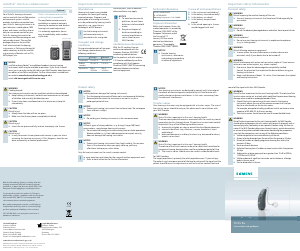

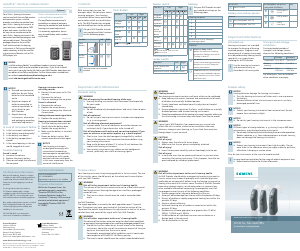

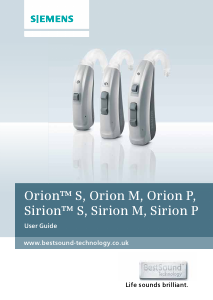
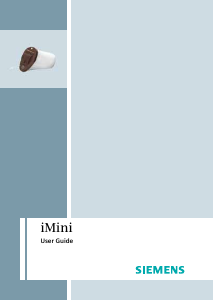
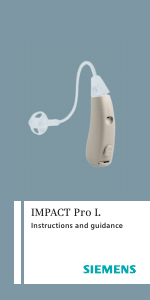

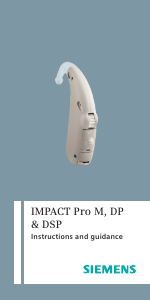

Join the conversation about this product
Here you can share what you think about the Siemens Octiv R+ Hearing Aid. If you have a question, first carefully read the manual. Requesting a manual can be done by using our contact form.